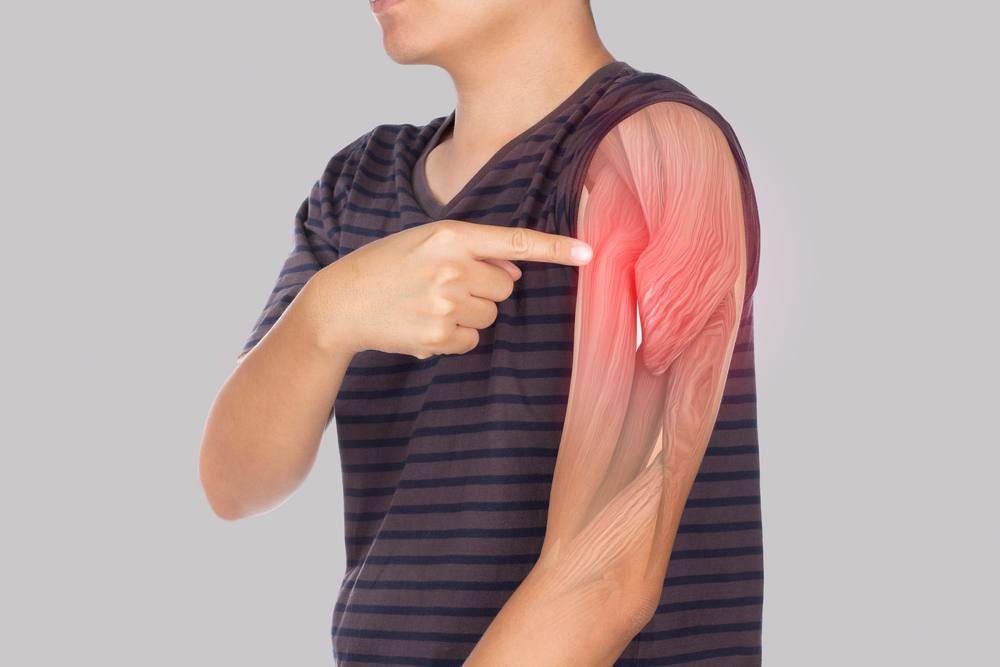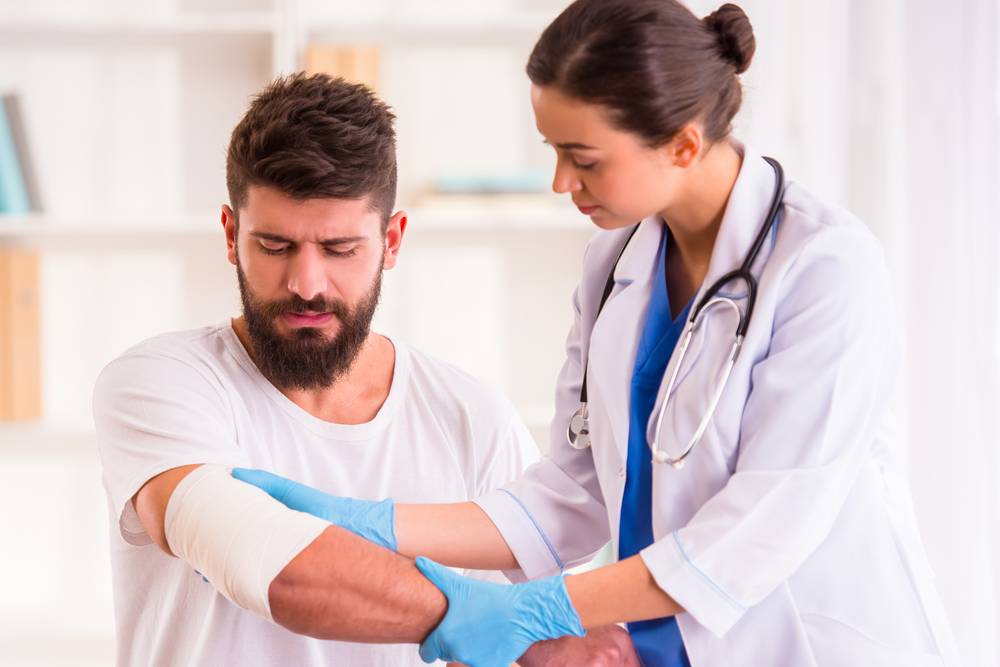
Everyone experiences aches and pains from time to time. But how do you know when you should see your doctor? A doctor can help determine what is actually causing your pain. When it comes to upper arm pain, you want to make sure you can go about your regular routines and participate in activities you enjoy. When pain keeps you from common movements and everyday tasks, you want to talk to your doctor. Upper arm pain may be caused by a sudden injury, an overuse injury, or may even occur as a symptom of a health condition. Your Atlanta orthopedic doctor can diagnose the cause of your upper arm pain and determine the right treatment plan for you.
Anatomy of the Upper Arm
The upper arm contains an arm bone called the humerus that connects the shoulder to the elbow and a series of muscles, tendons, and ligaments that support movement and range of motion. Your biceps are the muscles that run along the top of your arm and are commonly associated with a flexing motion of your upper arm. Biceps help you rotate your arm and flex your elbow, so you depend on these muscles for everyday movements like brushing your teeth or lifting a cup of water. Your triceps run along the back or underside of your upper arm and support arm movements that engage your elbow, shoulder, and forearm. Any time you straighten your arm, you engage the triceps.
What Upper Arm Pain Can Feel Like

Upper arm pain can manifest in various ways, making it crucial to understand the different sensations and their potential causes. The nature of your pain can provide valuable clues about its origin and help guide effective treatment.
Types of Upper Arm Pain
- Aching Pain: This is often a dull, persistent discomfort that can range from mild to severe. Aching pain is commonly associated with muscle strain, overuse injuries, or conditions like tendinitis and bursitis. It may worsen with specific movements or after periods of inactivity.
- Sharp or Stabbing Pain: Sharp pain can be sudden and intense, often described as a stabbing or piercing sensation. This type of stabbing pain in the upper arm is usually indicative of nerve-related issues, acute injuries, or serious conditions such as a rotator cuff tear or a dislocated shoulder.
- Burning Pain: A burning sensation can be particularly uncomfortable and is often linked to nerve compression or inflammation. Conditions like cervical radiculopathy or thoracic outlet syndrome can cause this type of pain.
- Radiating Pain: This pain extends from the upper arm into the shoulder other areas, like the neck, back, or hand. Radiating pain is typically a sign that nerves are involved and can occur with conditions like a herniated disc.
- Tingling or Numbness: These sensations are sometimes described as a “pins and needles” feeling. Numbness or tingling in the upper arm can be a symptom of conditions like carpal tunnel syndrome and peripheral neuropathy.
Stabbing Pain in Upper Arm: Right Side vs. Left Side
Stabbing pain in the upper arm can be alarming, but the location of your pain can provide critical insights to determine the cause. While pain in either arm can result from various musculoskeletal or nerve-related issues, pain in the left arm is particularly notable due to its potential association with heart problems. Here’s what to know about what causes stabbing pain in the upper arm, on the right versus the left side.
Right-Sided Upper Arm Pain
Pain in the right upper arm is often due to conditions such as muscle strain or overuse, like frequently using your arm for repetitive tasks, sports, or heavy lifting. Nerve impingement can also cause a sharp, stabbing pain in upper right arm depending on the location of a pinched or injured nerve. You might also be surprised to learn that stabbing pain in the right upper arm is a less common but possible symptom of gallbladder issues.
Left-Sided Upper Arm Pain and Heart Attack Warning
Pain in the left upper arm specifically can be a symptom of a heart attack. This type of pain is often referred to as “referred pain,” where the pain from the heart is felt in other parts of the body, such as the left arm, shoulder, neck, or jaw.
Signs of a Heart Attack
If you suspect that you or someone else might be having a heart attack, it is crucial to act quickly:
- Chest Discomfort: A feeling of pressure, squeezing, fullness, or pain in the center of the chest that lasts more than a few minutes or goes away and comes back.
- Pain in the Left Arm: This pain can be sharp or feel like a dull ache. It may radiate from the shoulder down to the arm and be accompanied by a heavy or squeezing sensation.
- Shortness of Breath: Often occurs with or without chest discomfort.
- Other Symptoms: These can include cold sweat, nausea, lightheadedness, or discomfort in other areas such as the back, neck, or jaw.
Call Emergency Services Immediately
Call emergency services (911) immediately. Time is of the essence in treating a heart attack. Try to remain as calm and still as possible to reduce the strain on the heart while waiting for emergency services to arrive. Provide first responders with as much information as possible about the symptoms, their onset, and any relevant medical history.
Regardless of the side affected, persistent or severe upper arm pain warrants medical evaluation to determine the underlying cause and appropriate treatment.
7 Causes of Upper Arm Pain
Whether you start noticing upper arm pain gradually or it occurs suddenly and feels quite severe, it can impact your typical movements and routines. Upper arm pain can occur in the muscles themselves, or you may notice stabbing pain in the upper arm that extends from your shoulder to your elbow. Different types of injuries and health conditions can impact what type of pain you experience and how long it lasts. Here are seven causes of pain in the upper arm.
- Muscle Strain
When muscles stretch too far out of their normal range of motion, it can lead to a strain. This type of injury can affect people of all ages, though muscle strains can be more common in athletes. A mild muscle strain may resolve on its own after a few days with rest and at-home care. However, a more moderate or severe muscle strain could also include muscle tears that cause inflammation and swelling in the area. You could strain your biceps or triceps from a sudden, single movement or repetitive motions that stress the area. A strain in the muscles that support your shoulder could also cause pain in your upper arm and temporarily restrict certain movements.
- Broken Bone
You may have suffered a broken bone if you experience sudden and severe pain after an accident. You could break your arm from falling on your hands with your arms outstretched or a sudden blow to the arm during a car accident or while playing sports. A broken bone, also known as a fracture, can require a cast to help hold your arm in place so the bone can heal properly. While a fractured wrist or forearm is quite common, breaking the upper arm bone is less common. A humerus fracture is more likely to occur at the top of the arm, just underneath the shoulder. This type of fracture will typically cause extreme pain, and you will likely be unable to move your arm. Severe swelling and bruising around your arm and shoulder can occur with a broken arm bone. For example, if you break your right arm, you may notice stabbing pain in upper right arm area that extends into the shoulder.
- Tendonitis
Tendonitis refers to an overuse injury that affects the tendons. Tendons are tough, fibrous tissue that connects muscles and bones together. When you engage in activities that put repeated stress on your muscles, tendons, and ligaments, you can start to feel sore. Repetitive movements can also lead to tendonitis and tiny tears in the tendons that support your upper arm and shoulder, like with swimmer’s shoulder. A bicep tendon injury like biceps tendonitis can also affect your shoulder or elbow joint, causing serious pain and swelling in the area. Athletes who play baseball, tennis, or golf can develop tendonitis from the repetitive motions required in these sports.
- Osteoarthritis
Osteoarthritis is the most common form of arthritis, which occurs due to general wear and tear on the joints as you age. Osteoarthritis causes the cartilage that supports your joints to break down over time, leading to bones rubbing against one another. If you develop elbow or shoulder arthritis, it can cause pain and discomfort in your arms as well. You may notice that your upper arm pain worsens with certain movements or activities when you have arthritis. Osteoarthritis commonly causes stiffness and swelling in the area around the affected joints, so your shoulder, arm, or elbow may feel especially sore and uncomfortable.
- Pinched Nerve
You might be surprised to learn that a pinched nerve in your neck could actually cause pain in your upper arm. When a nerve becomes irritated or compressed, it is known as a pinched nerve. A pinched nerve in your neck may cause a shooting or stabbing pain that runs through your neck, shoulder, and arm. Stabbing pain at top of the arm could result from an injury like a herniated disc that puts too much pressure on a nearby nerve. Poor posture and misalignments in the spine can also cause a pinched nerve. A pinched nerve in your arm or shoulder can also cause upper arm pain and lead to pain, tingling, and numbness that extend into your wrist and fingers.
- Joint Dislocation
A dislocated joint can cause sudden and extreme pain in and around the area. The arm relies on three main joints for motion and support: the shoulder, elbow, and wrist. A dislocation to any one of these can make certain movements and activities incredibly painful or even impossible. When the humerus, or upper arm bone, pops out of the socket of the shoulder joint, you will need to see a doctor to have it popped back into place. A dislocated joint should be treated as soon as possible to avoid any additional damage to surrounding muscles, ligaments, and tendons.
- Torn Rotator Cuff
Another type of shoulder injury that can cause pain in your upper arm is a torn rotator cuff. The rotator cuff refers to a group of muscles and tendons that help hold your shoulder joint in place. The main function of the rotator cuff is to allow you to move your shoulder and arm in all different directions. Irritation or damage to the rotator cuff can cause pain, weakness, and reduced range of motion. A rotator cuff injury could occur suddenly from lifting a heavy object or may develop over time from repetitive overhead motions. Upper arm pain from a rotator cuff injury typically worsens with certain motions and hurts more when you lie down on the affected side.
Acute Injuries vs. Overuse Injuries
An acute injury refers to a sudden trauma tied to a specific event, like a car accident injury. An overuse injury will have a more gradual onset, typically caused by repeated microtraumas to a particular area. Acute injuries that can cause sudden upper arm pain include a broken bone or joint dislocation. Overuse injuries that lead to increasing pain and discomfort over time include muscle strains, tendonitis, and osteoarthritis. Some arm injuries, like a torn rotator cuff, could be categorized as an acute injury or an overuse injury, depending on the cause. When you visit your doctor for upper arm pain, they will want to know if you can recall a specific moment or event where the pain started to occur, which can signal an acute injury. Otherwise, your doctor may want to assess you for overuse injuries and work with you to prevent this pain from occurring again in the future.
Treatment Options for Upper Arm Pain

Plan to see a doctor if you experience sudden upper arm pain or start noticing pain that has worsened over time. Your Atlanta orthopedic doctor will diagnose your upper arm pain accurately and develop an individualized plan of care to reduce your symptoms and address the root cause. Treatments for upper arm pain can range from home remedies like rest, icing the area, and anti-inflammatory medications. For a more serious injury or condition, your doctor may recommend physical therapy or other specialty services to support your recovery. At AICA Orthopedics, our doctors specialize in treating sports injuries, car accident injuries, and slip and fall injuries. Our doctors include orthopedists, neurologists, physical therapists, and chiropractors who all work together to provide you with quality, comprehensive care. Visit an AICA Orthopedics location in Atlanta near you, and don’t let upper arm pain keep you from the activities you enjoy!
